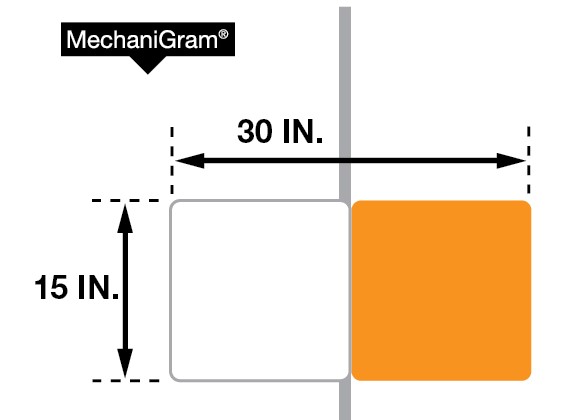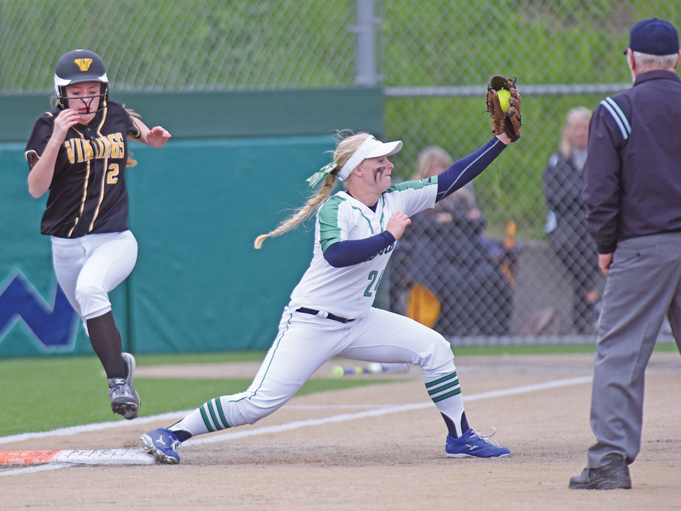In an effort to limit potential collisions and injuries, softball organizations have adopted the use of a double base at first base. And while the use of such bases is not mandatory in all codes, chances are you’ve come across them at some point in your career. While USA Softball requires a double base at first, NFHS rules allow state associations to adopt its usage, USSSA allows it but does not require it, and NCAA currently has its usage as an experimental rule (NFHS 1-2-1 Note; NCAA 2023 Experimental Rule; USA Softball 8-2n; USSSA 8-19).
The good news for umpires is the rules are pretty similar for all four codes, at least on the initial play at first base. There are some major differences after the initial play between NCAA rules and the other three codes, but let’s first take a look at the basics.
All four codes require the double base to be 15 inches by 30 inches with a white base in fair territory and a colored base located fully in foul territory (as shown in the MechaniGram). A batted ball hitting or bounding over the white portion of the bag is a fair ball. A batted ball hitting or bounding over the colored bag is foul.
 When it comes to making plays at first base, things get a little more complicated. When a play is being made on a batter-runner, the defense must use the white portion of the base and the batter-runner must use the colored portion, with some exceptions, which will be explained later. If a batter-runner uses only the white portion of the bag when a force play is being made at first and arrives before the ball, it is treated the same as if the batter-runner missed the bag. The defense must properly appeal before the batter-runner returns to touch either portion of the base.
When it comes to making plays at first base, things get a little more complicated. When a play is being made on a batter-runner, the defense must use the white portion of the base and the batter-runner must use the colored portion, with some exceptions, which will be explained later. If a batter-runner uses only the white portion of the bag when a force play is being made at first and arrives before the ball, it is treated the same as if the batter-runner missed the bag. The defense must properly appeal before the batter-runner returns to touch either portion of the base.
For throws coming from fair territory or from foul territory on the third-base side of the field, if there is a collision, the umpires must determine if it is incidental contact, interference or obstruction. If the batter-runner collides with the fielder who is only on the white portion of the bag attempting to catch the ball, it is interference. If the fielder is only standing on the colored portion of the bag and there is a collision prior to the fielder catching the ball, it is obstruction. If both players are doing what they are supposed to do and there is a collision, it may be incidental contact and no penalty assessed.
There are some situations where the fielder and batter-runner can use either portion of the bag. If the throw is coming to first base on a force play on the batter-runner from the foul side of the first-base line or if an errant throw pulls the fielder into foul territory, the fielder and batter-runner may use either base. This is where a lot of collisions are likely to occur. If a throw pulls the fielder into foul territory, there may not be enough time for the batter-runner to adjust and this is where contact most likely will occur. Umpires must determine if there is malicious contact or incidental contact and then also determine if there is obstruction if the fielder is in the way of the batter-runner and is not in possession of the ball.
Another caveat to the rule is when a batter-runner is required to run to first base, yet no play is being made on the batter-runner. In these instances, the batter-runner may utilize either base. However, after that is where the codes differ a little bit. In NFHS, USA Softball and USSSA, the double base becomes one big base. A runner may touch either base when returning to the bag, when tagging up to advance on a fly ball or when preparing to leave the base on a pitch. A fielder may also use either base when making a play on a returning runner.
NCAA rules differ, however, once the batter-runner reaches first base. In NCAA, the colored portion of the bag “disappears.” A runner must use the white portion of the bag. If only standing on the colored portion, it is considered the same as a runner not in contact with the base. The same is true for fielders. The fielder must touch the white portion of the bag when making a play on a returning runner. This is important to remember because a batter-runner who overruns the base and then returns to just the colored portion will be ruled out if tagged while on that colored portion only or if the ball is returned to the pitcher in the pitcher’s circle, the batter-runner would be called out for a look-back rule violation.
It is important to understand the rules when working with the double base to make sure you handle situations correctly. If you work multiple codes, it is vitally important to refresh yourself on the rules for that particular code that day. Study the rules, run through scenarios that may happen and remember to watch the entire play to make a correct ruling when you have a game using the double base.
What's Your Call? Leave a Comment:
Note: This article is archival in nature. Rules, interpretations, mechanics, philosophies and other information may or may not be correct for the current year.
This article is the copyright of ©Referee Enterprises, Inc., and may not be republished in whole or in part online, in print or in any capacity without expressed written permission from Referee. The article is made available for educational use by individuals.














